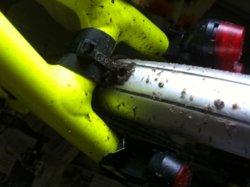A solution I found as working for vibration-caused damage is to put rubber or any energy absorbing (by deformation) material inbetween the mounts.
Aluminium rivets are crap in this application - the plastic from the mudguard frets them out from the inside, gradually causing more wiggling room, and exponential because the distance (amplitude) of the vibration increases and this in turn increases the fretting.
I solved this a couple times along a steel bolt+nut+2 big washers to spread out the pressure over the plastic + 2 old innertube rubber cuts sized to the washers with a hole for the bolt in them. The steel of the bolt is more resistent to the plastic of the mudguard, and the rubber avoids the need for a high torqued bolt that may crack the plastic despite the washers. Small diameter bolt - big washer combinations on themselves doesn't suffice since the washers then are thin and deform themselves, voiding the purpose of a washer. The rubber brings grip / movement resistence, and absorbs (part of) vibration energy.
btw, today I saw a left behind inner tyre along the road. I made a U-turn to pick it up. Inner tyre rubber has a thousand applications in the nonprofessional (read: cheap) part of the human world. I use it everywhere. Even my big backpack/frame has some rubber cut washers at the shoulder straps because I discovered the steel bolt heads that fix the straps to the frame were fretting out the top of the aluminium frame tube. I put 3 rubber washers inbetween both mounts and no more fretting out since.
Inner tyre rubber has a thousand applications in the nonprofessional (read: cheap) part of the human world. I use it everywhere. Even my big backpack/frame has some rubber cut washers at the shoulder straps because I discovered the steel bolt heads that fix the straps to the frame were fretting out the top of the aluminium frame tube. I put 3 rubber washers inbetween both mounts and no more fretting out since.
Aluminium rivets are crap in this application - the plastic from the mudguard frets them out from the inside, gradually causing more wiggling room, and exponential because the distance (amplitude) of the vibration increases and this in turn increases the fretting.
I solved this a couple times along a steel bolt+nut+2 big washers to spread out the pressure over the plastic + 2 old innertube rubber cuts sized to the washers with a hole for the bolt in them. The steel of the bolt is more resistent to the plastic of the mudguard, and the rubber avoids the need for a high torqued bolt that may crack the plastic despite the washers. Small diameter bolt - big washer combinations on themselves doesn't suffice since the washers then are thin and deform themselves, voiding the purpose of a washer. The rubber brings grip / movement resistence, and absorbs (part of) vibration energy.
btw, today I saw a left behind inner tyre along the road. I made a U-turn to pick it up.
 Inner tyre rubber has a thousand applications in the nonprofessional (read: cheap) part of the human world. I use it everywhere. Even my big backpack/frame has some rubber cut washers at the shoulder straps because I discovered the steel bolt heads that fix the straps to the frame were fretting out the top of the aluminium frame tube. I put 3 rubber washers inbetween both mounts and no more fretting out since.
Inner tyre rubber has a thousand applications in the nonprofessional (read: cheap) part of the human world. I use it everywhere. Even my big backpack/frame has some rubber cut washers at the shoulder straps because I discovered the steel bolt heads that fix the straps to the frame were fretting out the top of the aluminium frame tube. I put 3 rubber washers inbetween both mounts and no more fretting out since.
Last edited:

